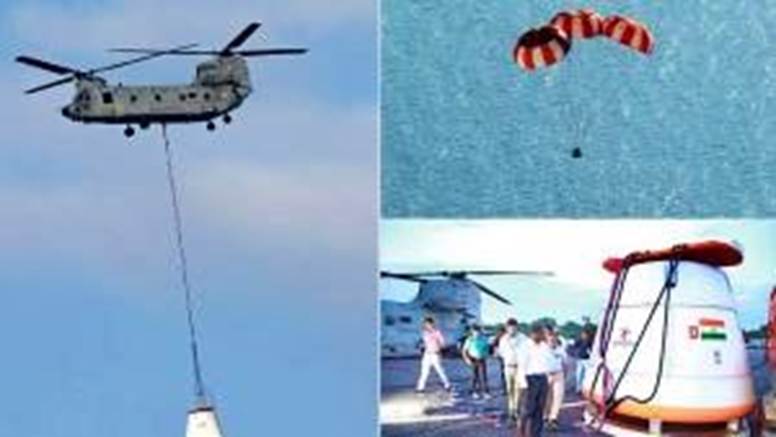What is IADT?
- Definition: An experimental test to validate the parachute-based deceleration system that slows down and safely lands the Gaganyaan crew module after atmospheric reentry.
- How conducted (Aug 24, 2025):
- 4.8–5 tonne dummy crew capsules dropped from 3 km altitude using an Indian Air Force Chinook helicopter.
- Parachutes deployed in sequence (pilot chute → drogue chute → three main chutes of 25 m each).
- Aim: Ensure safe splashdown in sea conditions within 8 m tolerance.
- Purpose: Replicate the last and most critical stage of a human spaceflight — safe recovery of astronauts.
Relevance : GS 3(Space )

Agencies Involved
- ISRO: Lead agency, developing human-rated systems.
- IAF (Indian Air Force): Provided Chinook helicopter.
- DRDO labs:
- DMRL: Defence Metallurgical Research Laboratory → heat-shield & structural materials.
- LRDE: Electronics & avionics for parachute and health monitoring.
- Navy & Coast Guard: Recovery readiness in case of failures or emergencies.
Why Multiple Tests are Needed
- Human spaceflight demands 99.9%+ reliability (vs ~90–95% for robotic missions).
- Tests ensure redundancy & safety under all possible failures:
- Crew Escape System (CES) – abort during launch.
- Air-drop tests – safe parachute deployment.
- Pad abort & in-flight abort tests – already demonstrated in 2018 & 2023.
- Uncrewed Gaganyaan missions (G1, G2) before actual astronauts.
- Hundreds of subsystem tests (ECLS, IVHMS, escape motors, composites) → certification before human flight.
Preparations for Gaganyaan
- Mission goal: Send 3 astronauts to Low Earth Orbit (LEO) for 3 days (~400 km altitude).
- Launcher: Human-rated LVM3 (GSLV Mk-III) rocket.
- Milestones:
- TV-D1 (Oct 2023) → CES pad abort success.
- TV-D2 (Dec 2023) → helicopter abort test.
- TV-D3 (2024) → multiple abort scenarios.
- G1 (Apr 2024) → first uncrewed orbital flight with Vyommitra humanoid robot.
- Crewed H1 mission → post-2025 after full validation.
India’s Long-Term Spaceflight Roadmap
- Not just Gaganyaan → foundation for broader human space program.
- Key milestones announced:
- Bharatiya Antariksh Station (BAS) in Low Earth Orbit by 2035.
- Crewed lunar landing by 2040.
- Technologies needed:
- Reusable launch vehicles.
- Advanced life-support & environmental systems.
- Deep-space propulsion & radiation protection.
- Habitability modules for orbital stations.
Strategic & Economic Significance
- Prestige: India joins elite club (US, Russia, China) in human spaceflight.
- Technology spin-offs: Materials science, robotics, AI, avionics, composites, life-support tech.
- Geopolitical leverage: Space diplomacy → collaborations with NASA, ESA, JAXA, Roscosmos.
- Economic multiplier: Indigenous tech fosters aerospace, defense, MSME ecosystem.
Challenges
- Cost: Gaganyaan budget ~₹9,000–10,000 crore (excluding BAS & lunar mission).
- Safety: Astronaut life-risk → zero margin of error.
- Delays: Pandemic, supply chain disruptions, and technology development slowed timelines (original crewed flight target: 2022, now ~2025–26).
- Capability gap: Human-rating rockets, radiation shielding, long-duration life support still under development.
Big Picture
- IADT success = critical milestone → validates safe astronaut recovery.
- Gaganyaan = stepping stone → India’s roadmap is about sustained human presence in space, not just one-off missions.
- Aligns with “Viksit Bharat @2047” vision: tech leadership, self-reliance, and space power status.



